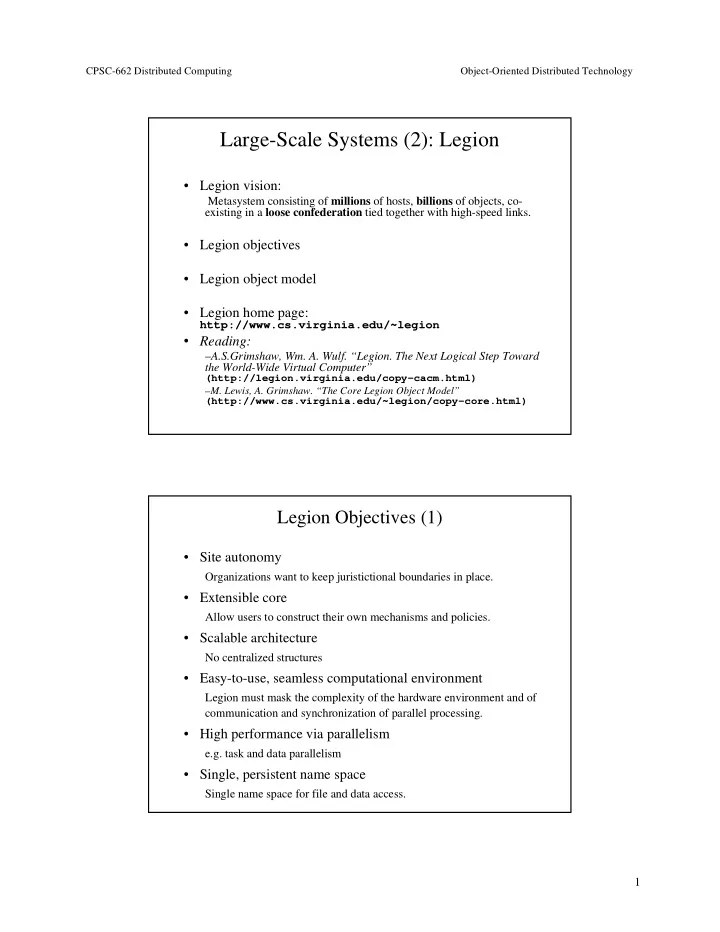

CPSC-662 Distributed Computing Object-Oriented Distributed Technology Large-Scale Systems (2): Legion • Legion vision: Metasystem consisting of millions of hosts, billions of objects, co- existing in a loose confederation tied together with high-speed links. • Legion objectives • Legion object model • Legion home page: http://www.cs.virginia.edu/~legion • Reading: – A.S.Grimshaw, Wm. A. Wulf. “Legion. The Next Logical Step Toward the World-Wide Virtual Computer” (http://legion.virginia.edu/copy-cacm.html) – M. Lewis, A. Grimshaw. “The Core Legion Object Model” (http://www.cs.virginia.edu/~legion/copy-core.html) Legion Objectives (1) • Site autonomy Organizations want to keep juristictional boundaries in place. • Extensible core Allow users to construct their own mechanisms and policies. • Scalable architecture No centralized structures • Easy-to-use, seamless computational environment Legion must mask the complexity of the hardware environment and of communication and synchronization of parallel processing. • High performance via parallelism e.g. task and data parallelism • Single, persistent name space Single name space for file and data access. 1
CPSC-662 Distributed Computing Object-Oriented Distributed Technology Legion Objectives (2) • Security for users and resource owners Cannot strengthen existing OS protection and security mechanisms. Existing mechanisms should not be weakened by Legion. Need mechanisms for users to manage security needs. • Management and exploitation of resource heterogeneity Inter-operability between heterogeneous hardware and software components. • Multiple language support and inter-operability Integrate heterogeneous source language applications, support for legacy codes. • Fault-tolerance Dealing with failure and dynamic re-configuration Constraints ... cannot replace host operating systems Operate at middleware level. ... cannot legislate changes to the interconnection network Can layer better protocols over existing ones. ... cannot require that Legion run as “root” Most Legion users want it to run with the least possible privileges. 2
CPSC-662 Distributed Computing Object-Oriented Distributed Technology The Core Legion Object Model • Each object belongs to class; each class is itself an object. • Object-mandatory member functions: – may_I(), save_state(), restore_state() • Class-mandatory member functions: – create(), derive(), inherit_from() • User-level class objects responsible for managing instances and subclasses: – creation, location, security policies, object placement policies Security • Various users can have wide variety of security concerns. • Provide users with mechanisms to build robust security measures. • Message layer: – Inter-object communication and authentication • Discretionary layer: – Access control predicate may_I(); must be called before invoking any method. • Mandatory layer: – Legion objects can act as Security Agents; monitor other objects. 3
CPSC-662 Distributed Computing Object-Oriented Distributed Technology Naming and Binding • LOID : Every Legion object is named by a Legion Object Identifier. Class Instance Format Public Key Identifier Number • Format: defines size, format of other fields • Class identifier: handled by LegionClass • Instance number: handled by class object • Public key: allows entire LOID to be used as public key for object. • Binding: LOIDs have meaning only at Legion level. Need to be bound to names that have meaning at underlying protocol levels. Binding • Need physical Object Address to communicate with another object. Object Address Semantics Address Number of addresses Address Type Address Object Address Type Address Address Address Type Address Elements Address Type Address • Binding: (LOID, Object Address, invalidation time); first class entities. • Binding Agents: derived from LegionBindingAgent . – binding get_binding(LOID); binding get_binding(binding) – invalidate_binding(LOID); invalidate_binding(binding) – add_binding(binding) 4
CPSC-662 Distributed Computing Object-Oriented Distributed Technology Object States • Active objects are running as process on Legion Host and can be accessed via an Object Address. • Inert objects exist in persistent storage – Controlled by Legion Vault – Described by Object Persistent Representation (OPR) – Located using Object Persistent Address (OPA) • Object Persistent Representation: – Every object exports save_state() and restore_state() methods. – Objects can carry state when they migrate between hosts. • Object Persistent Address: – Analogous to Object Address of active object. – Typically file name, meaningful to Legion Vault. Class Objects • Class objects export class-mandatory member functions to – create new instances: create() – create new subclasses: derive() – delete instances: delete() – find instances and subclasses: get_binding() • Assigns LOID to instances and subclasses – For new instance: • assign Class Identifier to match own • assign Instance Number as it sees fit – For new subclass: • Contact LegionClass to obtain new Class Identifier • Logically maintain table for objects: – LOID, Object Address, Placement Mapper, Current Vault Set, Candidate Vault Set. 5
CPSC-662 Distributed Computing Object-Oriented Distributed Technology Mechanisms: Binding • Model: – Ultimatively, responsibility for providing bindings lays with class. – To support scalability, other objects may be involved as well. C.get_binding(B) Binding Agent BA Class C Binding Logical Table Cache BA.get_binding(B) Object A Object B BA Binding LOID for B Cache – How to find responsible class object? Scalability • Scalable Architecture : “As the number of processors increases, the granularity of computation does not need to increase to keep the machine balanced.” – e.g. hypercubes, meshes, tori, rings. – Problem: Scalability of architecture must be claimed with respect to particular application • Distributed Systems Principle : “The number of requests to any particular system component must not be an increasing function of the number of hosts or objects in the system.” 6
Recommend
More recommend